Ding Ma
Nemotron-H: A Family of Accurate and Efficient Hybrid Mamba-Transformer Models
Apr 10, 2025Abstract:As inference-time scaling becomes critical for enhanced reasoning capabilities, it is increasingly becoming important to build models that are efficient to infer. We introduce Nemotron-H, a family of 8B and 56B/47B hybrid Mamba-Transformer models designed to reduce inference cost for a given accuracy level. To achieve this goal, we replace the majority of self-attention layers in the common Transformer model architecture with Mamba layers that perform constant computation and require constant memory per generated token. We show that Nemotron-H models offer either better or on-par accuracy compared to other similarly-sized state-of-the-art open-sourced Transformer models (e.g., Qwen-2.5-7B/72B and Llama-3.1-8B/70B), while being up to 3$\times$ faster at inference. To further increase inference speed and reduce the memory required at inference time, we created Nemotron-H-47B-Base from the 56B model using a new compression via pruning and distillation technique called MiniPuzzle. Nemotron-H-47B-Base achieves similar accuracy to the 56B model, but is 20% faster to infer. In addition, we introduce an FP8-based training recipe and show that it can achieve on par results with BF16-based training. This recipe is used to train the 56B model. All Nemotron-H models will be released, with support in Hugging Face, NeMo, and Megatron-LM.
Two-stage Framework for Robust Speech Emotion Recognition Using Target Speaker Extraction in Human Speech Noise Conditions
Sep 29, 2024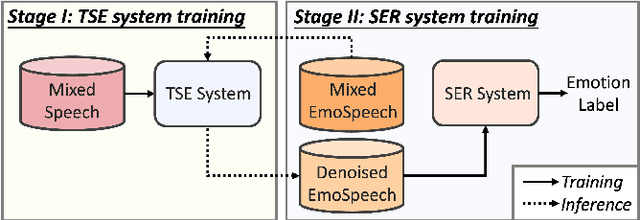

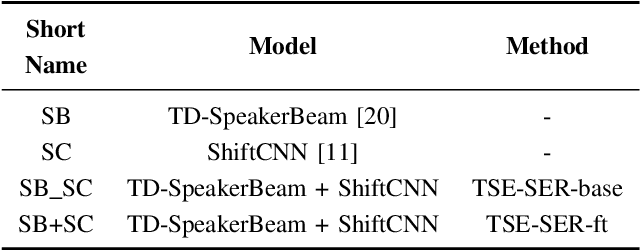
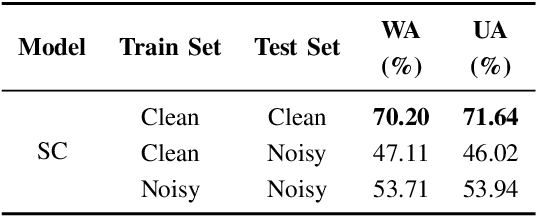
Abstract:Developing a robust speech emotion recognition (SER) system in noisy conditions faces challenges posed by different noise properties. Most previous studies have not considered the impact of human speech noise, thus limiting the application scope of SER. In this paper, we propose a novel two-stage framework for the problem by cascading target speaker extraction (TSE) method and SER. We first train a TSE model to extract the speech of target speaker from a mixture. Then, in the second stage, we utilize the extracted speech for SER training. Additionally, we explore a joint training of TSE and SER models in the second stage. Our developed system achieves a 14.33% improvement in unweighted accuracy (UA) compared to a baseline without using TSE method, demonstrating the effectiveness of our framework in mitigating the impact of human speech noise. Moreover, we conduct experiments considering speaker gender, showing that our framework performs particularly well in different-gender mixture.
Electrolaryngeal Speech Intelligibility Enhancement Through Robust Linguistic Encoders
Sep 18, 2023



Abstract:We propose a novel framework for electrolaryngeal speech intelligibility enhancement through the use of robust linguistic encoders. Pretraining and fine-tuning approaches have proven to work well in this task, but in most cases, various mismatches, such as the speech type mismatch (electrolaryngeal vs. typical) or a speaker mismatch between the datasets used in each stage, can deteriorate the conversion performance of this framework. To resolve this issue, we propose a linguistic encoder robust enough to project both EL and typical speech in the same latent space, while still being able to extract accurate linguistic information, creating a unified representation to reduce the speech type mismatch. Furthermore, we introduce HuBERT output features to the proposed framework for reducing the speaker mismatch, making it possible to effectively use a large-scale parallel dataset during pretraining. We show that compared to the conventional framework using mel-spectrogram input and output features, using the proposed framework enables the model to synthesize more intelligible and naturally sounding speech, as shown by a significant 16% improvement in character error rate and 0.83 improvement in naturalness score.
Intermediate Fine-Tuning Using Imperfect Synthetic Speech for Improving Electrolaryngeal Speech Recognition
Nov 02, 2022



Abstract:Research on automatic speech recognition (ASR) systems for electrolaryngeal speakers has been relatively unexplored due to small datasets. When training data is lacking in ASR, a large-scale pretraining and fine tuning framework is often sufficient to achieve high recognition rates; however, in electrolaryngeal speech, the domain shift between the pretraining and fine-tuning data is too large to overcome, limiting the maximum improvement of recognition rates. To resolve this, we propose an intermediate fine-tuning step that uses imperfect synthetic speech to close the domain shift gap between the pretraining and target data. Despite the imperfect synthetic data, we show the effectiveness of this on electrolaryngeal speech datasets, with improvements of 6.1% over the baseline that did not use imperfect synthetic speech. Results show how the intermediate fine-tuning stage focuses on learning the high-level inherent features of the imperfect synthetic data rather than the low-level features such as intelligibility.
Two-stage training method for Japanese electrolaryngeal speech enhancement based on sequence-to-sequence voice conversion
Oct 19, 2022



Abstract:Sequence-to-sequence (seq2seq) voice conversion (VC) models have greater potential in converting electrolaryngeal (EL) speech to normal speech (EL2SP) compared to conventional VC models. However, EL2SP based on seq2seq VC requires a sufficiently large amount of parallel data for the model training and it suffers from significant performance degradation when the amount of training data is insufficient. To address this issue, we suggest a novel, two-stage strategy to optimize the performance on EL2SP based on seq2seq VC when a small amount of the parallel dataset is available. In contrast to utilizing high-quality data augmentations in previous studies, we first combine a large amount of imperfect synthetic parallel data of EL and normal speech, with the original dataset into VC training. Then, a second stage training is conducted with the original parallel dataset only. The results show that the proposed method progressively improves the performance of EL2SP based on seq2seq VC.
TCDCaps: Visual Tracking via Cascaded Dense Capsules
Feb 26, 2019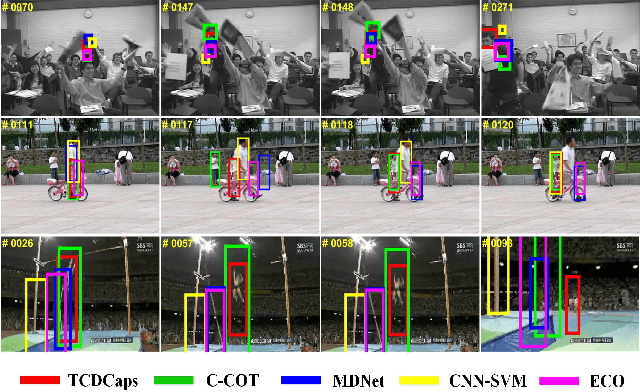
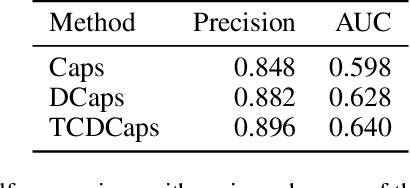


Abstract:The critical challenge in tracking-by-detection framework is how to avoid drift problem during online learning, where the robust features for a variety of appearance changes are difficult to be learned and a reasonable intersection over union (IoU) threshold that defines the true/false positives is hard to set. This paper presents the TCDCaps method to address the problems above via a cascaded dense capsule architecture. To get robust features, we extend original capsules with dense-connected routing, which are referred as DCaps. Depending on the preservation of part-whole relationships in the Capsule Networks, our dense-connected capsules can capture a variety of appearance variations. In addition, to handle the issue of IoU threshold, a cascaded DCaps model (CDCaps) is proposed to improve the quality of candidates, it consists of sequential DCaps trained with increasing IoU thresholds so as to sequentially improve the quality of candidates. Extensive experiments on 3 popular benchmarks demonstrate the robustness of the proposed TCDCaps.
 Add to Chrome
Add to Chrome Add to Firefox
Add to Firefox Add to Edge
Add to Edge